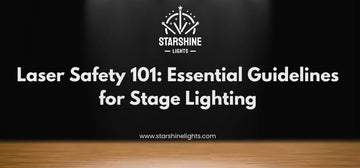Safety Guidelines and Regulations for Stage Laser Lights
Ensuring the safety of performers, technicians, and audiences is paramount when using stage laser lighting. This guide outlines essential laser safety principles, regulatory requirements, and best practices for venue managers, regulatory authorities, and technicians working with everything from a small laser projector to a high‑power laser light show projector outdoor.

1. Understand Laser Classifications
Lasers are categorized by output power and potential hazard:
Class 1 & 1M: Safe under normal operation (e.g., many home laser projectors and star laser projectors).
Class 2 & 2M: Low-power visible lasers; eye-safe for brief exposure (often found in christmas laser light projectors).
Class 3R & 3B: Moderate-power; direct beam viewing can be hazardous (common in programmable laser projectors and laser animation projectors).
Class 4: High-power; capable of causing skin and eye injury, and fire risk (typical in laser projector outdoor and laser lights projectors used for large events).
Always verify the class rating before installation and operation.
2. Comply with Local and International Regulations
2.1 International Standards
IEC 60825-1: Global standard for laser safety classification and labeling.
ANSI Z136.1: U.S. standard outlining safe use of lasers in entertainment and research.
2.2 National and Local Requirements
FDA/CDRH (U.S.): Regulations for laser products; requires variance for public laser shows.
HSE (UK): Health & Safety Executive guidelines for entertainment lighting.
Local Authorities: Many cities require permits for laser light show projector outdoor events—check municipal codes.

3. Establish a Laser Safety Program
A comprehensive safety program should include:
Designation of a Laser Safety Officer (LSO): Responsible for risk assessments, training, and compliance.
Written Procedures: Document setup, operation, maintenance, and emergency protocols.
Training and Certification: Ensure all technicians understand beam hazards, eye protection, and safe alignment methods.
Safety Audits: Regular inspections of equipment like the J5 Bluetooth Laser Light or the versatile J1 RGB Laser Lights to confirm safety interlocks and beam stops are functional.
4. Best Practices for Safe Installation and Operation
4.1 Site Assessment
Controlled Areas: Define and clearly mark beam paths; restrict access during alignment.
Audience Scanning: Never allow direct laser exposure to spectators. Use beam stops or automatic cut-offs.
4.2 Equipment Setup
Mounting and Stability: Secure fixtures—whether a smart laser projector or a small laser projector—to prevent movement.
Interlock Systems: Use hardware/software interlocks to disable beams if safety boundaries are breached.
Dynamic Effects: For events that require vibrant, multi-mode displays, consider setups featuring C2 Party Laser Lights which offer built-in safety features along with dynamic visual effects.
4.3 Personal Protective Equipment (PPE)
Laser Safety Eyewear: Select eyewear rated for the specific wavelength and class of your laser.
Protective Clothing: For Class 4 systems, consider flame‑resistant clothing if high‑power beams are near combustible materials.
5. Special Considerations for Themed and Seasonal Installations
Christmas Laser Light Projectors & Laser Projector Christmas Lights: Ensure festive shows comply with both laser and holiday‑lighting electrical safety standards.
Home and Church Settings: Devices like home laser projectors and laser projector for church often operate in mixed‑use spaces—verify that beam paths never intersect audience areas, and employ low‑power Class 1/2 units when possible.
Ambient Effects: For a mesmerizing backdrop, the Starry Sky Light is ideal for projecting ambient celestial visuals safely in various environments.

6. Emergency Procedures
Beam Shutdown: Equip all systems with an easily accessible emergency stop.
First Aid: Train staff to respond to eye or skin exposure incidents.
Incident Reporting: Document any safety breaches or injuries and review procedures to prevent recurrence.
Adhering to laser safety guidelines and regulations protects both people and property. By understanding laser classifications, complying with standards like IEC 60825-1 and ANSI Z136.1, and implementing a robust safety program, venue managers, regulatory authorities, and technicians can confidently use everything from laser lights projectors to advanced laser animation projectors. Prioritize training, site control, and emergency preparedness to ensure every show is both spectacular and safe.

Embrace these safety best practices and regulations to create a safe and impressive environment for every laser light show. Stay informed, stay safe, and let your creative displays shine responsibly!



























